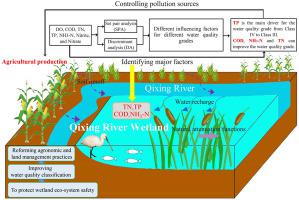当前位置:
X-MOL 学术
›
Ecol. Eng.
›
论文详情
Our official English website, www.x-mol.net, welcomes your
feedback! (Note: you will need to create a separate account there.)
Understanding the risks from diffuse pollution on wetland eco-systems: The effectiveness of water quality classification schemes
Ecological Engineering ( IF 3.9 ) Pub Date : 2020-08-01 , DOI: 10.1016/j.ecoleng.2020.105929 Song Cui , Ting Yu , Fuxiang Zhang , Qiang Fu , Rupert Hough , Lihui An , Shang Gao , Zulin Zhang , Peng Hu , Qiande Zhu , Zhongxu Pei
Ecological Engineering ( IF 3.9 ) Pub Date : 2020-08-01 , DOI: 10.1016/j.ecoleng.2020.105929 Song Cui , Ting Yu , Fuxiang Zhang , Qiang Fu , Rupert Hough , Lihui An , Shang Gao , Zulin Zhang , Peng Hu , Qiande Zhu , Zhongxu Pei

|
Abstract Eco-environmental safety and health is an important concept for the protection of flora and fauna in the wetland eco-system. Identifying impacts of human activities on wetland ecology and risk factors of environmental decline have become significant components of habitat protection. In this study, the Qixing River wetland, one of the Ramsar Sites, was taken as the research area. Seven water quality indices, including dissolved oxygen (DO), chemical oxygen demand (COD), ammonia nitrogen (NH3−N), total phosphorus (TP), total nitrogen (TN), nitrates and nitrites were monitored at fifteen sampling locations. Entropy weight-set pair analysis, combined with discriminant analysis, was used to identify the most sensitive indicators for changes in water quality. Average concentrations for the indicators measured were: DO 7.24 (4.64–9.98) mg/L; COD 21.67 (5–50) mg/L; NH3-N 1.09 (0.41–2.15) mg/L; TP 0.18 (0.10–0.73) mg/L; TN 1.38 (0.76–2.17) mg/L, nitrite 0.016 (ND ~ 0.030) mg/L and nitrate concentration was 0.420 (0.315–0.613) mg/L. Water quality was found to be poorest at locations closer to sources of diffuse pollution such as agricultural land. In contrast, the more remote buffer zone and core zone of the wetland was characterized by improved indicators of water quality. The results of entropy weight-set pair analysis showed that the overall water quality grade of Qixing River wetland conforms to Class III of the “Environmental Quality Standards for Surface Water” of China (GB3838-2002). Discriminant analysis indicated that TP was the main contributory factor to reduced water quality classification while COD, ammonia nitrogen and total nitrogen were the key drivers of improving water quality grade and responsible for the Class III award. The prominence of these indicators is indicative of long-term use of fertilizers and pesticides in agricultural production. The more remote core area of the wetland was less affected by human activities, reflected in improved water quality results. The results showed that entropy weight-set pair analysis coupled with discriminant analysis adds value to widely used water environment quality indices and helps identify the main environmental factors driving water quality classification. In the case of the Qixing River wetland, there is clear potential to protect wetland eco-system safety by improving the water quality classification and reforming agronomic and land management practices.
更新日期:2020-08-01









































 京公网安备 11010802027423号
京公网安备 11010802027423号